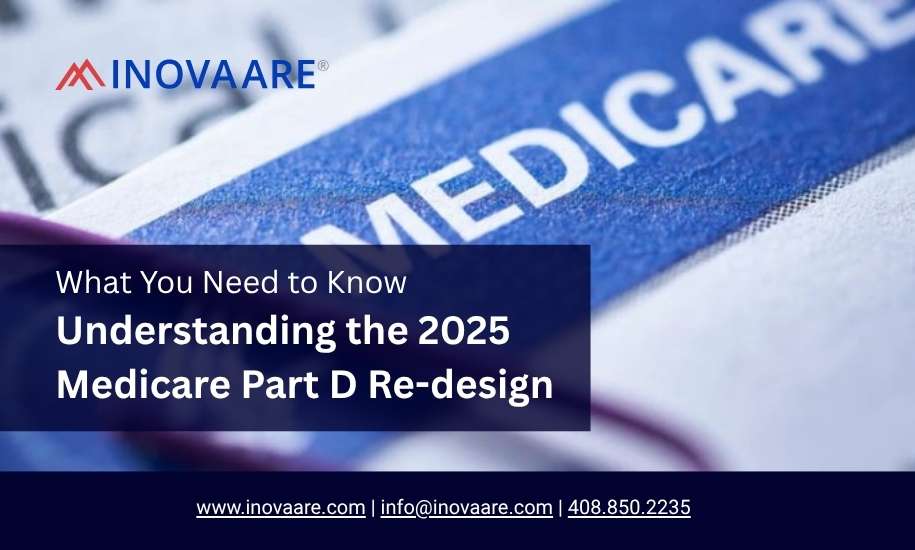The Prescription Drug Program, commonly known as Medicare Part D, is undergoing significant transformations in 2025 due to the Inflation Reduction Act (IRA) of 2022. These changes mark a pivotal shift from its original structure in 2006. Understanding these changes is crucial for stakeholders, as they impact various aspects of the program, from beneficiary cost sharing to the introduction of new manufacturer discount programs. This blog delves into the details of these changes and their implications for plan sponsors and beneficiaries.
The transformational changes in 2025 are highlighted below.
- Medicare Part D will have three (3) phases instead of four (4) – Deductible, Initial Coverage Phase and Catastrophic Phase.
- Beneficiary cost sharing will be capped at $2,000 for prescription drugs, which means copay or cost-sharing will be zero after paying $2,000 out of pocket for Part D drugs. This is like the Maximum Out-Of-Pocket or MOOP structure for Part B.[1] Some beneficiaries can enter a catastrophic phase on Day 1 of the contract year with a high-cost drug.[2]
- The current Coverage Gap Discount Program (CGDP), pursuant to the Affordable Care Act 2010,[3] will be sunset on December 31, 2024. CGDP will be replaced with a new Manufacturer Discount Program (MDP) in 2025. Drugs offered by manufacturers not having a fully executed discount program agreement in effect are not Part D eligible. All Part D beneficiaries will be eligible for the MDP whether they have a low-income subsidy (LIS). Discounts do not count toward the beneficiary’s incurred costs.
- With the elimination of the Coverage Gap and implementation of MDP, pharmaceutical manufacturers will pay 10% of the allowed cost of the drugs that is a brand or applicable drug in the initial coverage phase and 20% of the allowed cost of the applicable drug in the catastrophic phase when a beneficiary reaches the MOOP. This program will initially apply to all large pharmaceutical manufacturers and will be phased in for small manufacturers. This increase will have the biggest impact on drugs that cost thousands of dollars per fill, such as specialty drugs, in which costs for some manufacturers could increase fourfold (or higher) over levels in 2024.[4]
If manufacturers resort to raising the list prices for their drugs, they are subject to the IRA provision of inflation-based penalty payments if prices increase faster than inflation. - In the catastrophic phase, federal reinsurance will decrease to 20% of the allowed cost for applicable drugs and 40% for non-applicable drugs (e.g., generics). Drug plan liability for applicable drugs will increase to 60% in 2025.[5]
- Medicare Part D enrollees will have the option of paying out-of-pocket costs in monthly installments over the plan year rather than face high out-of-pocket costs in any given month. Their Part D premium increase will be limited to 6% from the prior year.
Drug plans have long depended on rebates from drug manufacturers to defray Part D premium increases. With help from pharmacy benefit managers (PBM), drug plans have used formulary designs such as inclusions and tier placements to enhance their rebate intake. CMS will implement negotiated pricing based on maximum fair price (MFP) in 2026 on ten (10) selected drugs. Rebates from the selected drugs may change. Additional drugs will be selected for negotiation every year after 2025.[6]
A compound drug not approved by the FDA under a New Drug Application or Biological License Application does not meet the definition of an applicable drug and will not be eligible for Part D. Non-applicable drugs (i.e., generic drugs) will be coverable under Part D whether or not the manufacturer participates in the MDP.
CMS will continue to provide monthly prospective Discount Program payments to drug plans. The prospective payments will be based on the projections in the plan’s bid and current enrollment. CMS will estimate the per member per month cost of the manufacturer discounts for each plan based on a percentage of the cost assumptions submitted with plan bids.
These forthcoming changes should be communicated to all stakeholders in the plan that offers prescription drug benefits, in particular, the finance department that will work with the actuary to prepare the bids (submission in June), the product design team, the sales force, and the compliance department overseeing the implementation of the changes. It is not too early to begin planning.
Inovaare’s SME Expertise
Inovaare has a longstanding history of guiding plan sponsors through regulatory changes in the Medicare Advantage and Prescription Drug program. With a team of compliance specialists, Inovaare provides in-depth technical expertise and compliance preparedness evaluation, guidance, and support. This encompasses assisting with operational challenges and ensuring adherence to new regulations. Inovaare’s proficiency in managing transitions in the healthcare sector positions it as a trusted advisor for navigating the complexities of Part D changes.
Are you prepared for the Medicare Part D changes in 2025? Contact Inovaare for expert guidance on navigating these transformations. Call us at 1.408.850.2235 or email us at info@inovaare.com
[1] After meeting the MOOP, beneficiaries do not pay anything for Part B benefits.
[2] This will depend on the benefit design with respect to deductibles and cost-sharing in the Initial Coverage Limit.
[3] Over several years, the “donut hole” or coverage gap for Part D has been closing since 2011.
[4] https://www.milliman.com/en/insight/part-d-redesign-under-ira-potential-financial-ramifications
[5] The Inflation Reduction Act of 2022: One Year Anniversary Highlights from ASPE Drug Pricing Reports, August 16, 2023
[6] In 2026, CMS will select 15 drugs for price negotiation that are covered under Part D or Part B and 20 drugs in 2027.
